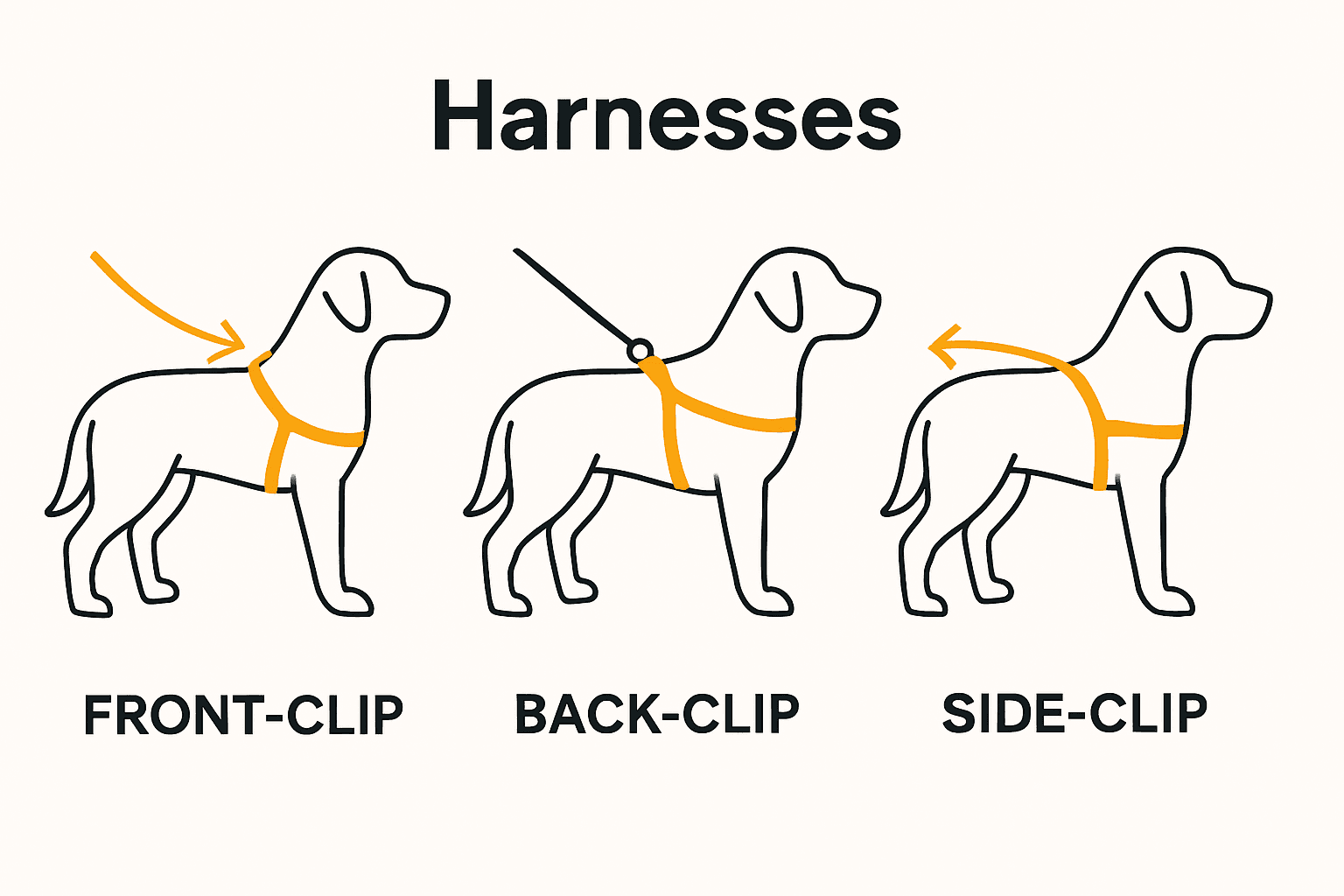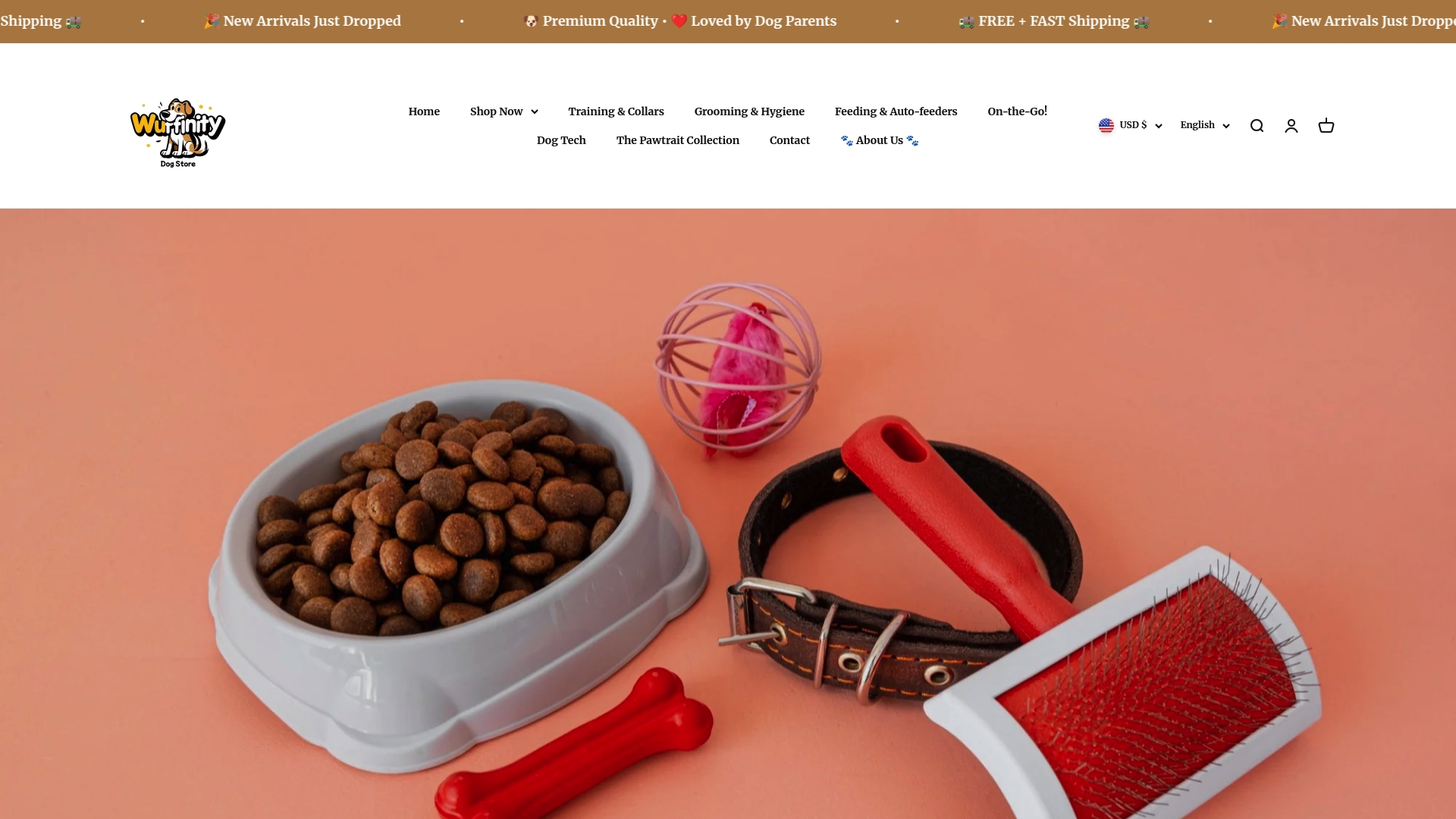No-pull harnesses have changed daily dog walks for millions of owners facing stubborn leash behavior. Over 30 percent of dog owners report leash pulling as their top training struggle. You might think a collar is enough to solve the problem. Turns out, switching to a no-pull harness is not just about control. It completely shifts how you and your dog communicate and build trust every time you clip on the leash.
Table of Contents
- What Are No-Pull Harnesses And Their Purpose?
- Why No-Pull Harnesses Matter For Dog Training
- How Different Designs Of No-Pull Harnesses Work
- Key Features Of Effective No-Pull Harnesses
- Real-World Context: Choosing The Right Harness
Quick Summary
| Takeaway | Explanation |
|---|---|
| No-pull harnesses reduce leash pulling. | These harnesses redirect a dog’s pulling instincts, creating gentle pressure that encourages better behavior during walks. |
| Front-clip harnesses offer better control. | This design helps to naturally turn the dog when it pulls, making walks more manageable for handlers. |
| Select harnesses based on dog personality. | Understanding your dog’s behavior is essential; energetic breeds might need sturdier designs, while smaller dogs benefit from lighter options. |
| Choose breathable materials for comfort. | Quality harnesses use lightweight, moisture-wicking fabrics that minimize irritation, improving your dog’s walking experience. |
| Harnesses enhance the bond between dogs and owners. | By promoting positive reinforcement, no-pull harnesses can transform walking challenges into enjoyable shared experiences, fostering trust. |
What are No-Pull Harnesses and Their Purpose?
No-pull harnesses represent an innovative solution for dog owners struggling with leash pulling behaviors. According to the ASPCA, these specialized harnesses are designed to discourage pulling while providing a safer and more comfortable walking experience for both dogs and their handlers.
Understanding the Core Mechanics
Unlike traditional collars that concentrate pressure on a dog’s sensitive neck area, no-pull harnesses strategically distribute force across the chest and body. This design serves multiple crucial purposes:
- Prevents potential neck and trachea injuries
- Offers better control without causing discomfort
- Reduces the likelihood of choking or respiratory stress
The fundamental mechanism works through gentle redirection. When a dog attempts to pull forward, the harness creates a slight turning motion that naturally discourages the pulling behavior. This subtle physical intervention helps train dogs to walk more cooperatively without causing pain or excessive restraint.
Why Dog Owners Choose No-Pull Harnesses
Owners select these harnesses for various compelling reasons. Whether managing an energetic puppy, training an adult dog, or addressing long-standing walking challenges, no-pull harnesses provide a humane training tool. Our guide on dog harness types offers more detailed insights into selecting the right harness for specific dog temperaments.
The primary goal of a no-pull harness goes beyond simple control it represents a training philosophy that emphasizes positive reinforcement and gentle guidance. By making walking more comfortable and less stressful, these harnesses help strengthen the bond between dogs and their owners, transforming challenging walks into enjoyable shared experiences.
Why No-Pull Harnesses Matter for Dog Training
Dog training represents a nuanced process of communication and behavioral modification, where tools like no-pull harnesses play a critical strategic role. Research from the Journal of Veterinary Behavior highlights that effective training equipment can significantly impact a dog’s learning trajectory and owner-dog relationship.
Psychological Impact of Training Tools
No-pull harnesses transcend mere physical restraint they represent a sophisticated approach to behavioral guidance. By understanding the psychological principles behind these training tools, owners can transform challenging walking experiences into opportunities for positive reinforcement and mutual understanding.
Key psychological benefits include:
- Reducing stress and anxiety during walks
- Promoting positive associative learning
- Establishing clear communication boundaries
Building Trust Through Gentle Correction
The fundamental philosophy of no-pull harnesses centers on gentle redirection rather than punishment. When a dog begins to pull, the harness creates a subtle physical feedback mechanism that guides them back to desired walking behavior. This approach contrasts sharply with punitive training methods that can damage the dog’s trust and emotional connection with their handler.
What is the Best Dog Harness to Stop Pulling? Our comprehensive guide offers deeper insights into selecting the most effective training tools that align with positive reinforcement principles.
Ultimately, no-pull harnesses represent more than a training accessory. They are a bridge of communication, transforming potential frustration into an opportunity for strengthening the profound bond between dogs and their human companions. By prioritizing comfort, safety, and psychological well-being, these harnesses embody a modern, compassionate approach to dog training.
How Different Designs of No-Pull Harnesses Work
According to the ASPCA, no-pull harnesses are not a one-size-fits-all solution but rather a diverse category of training tools designed to address different canine behavioral patterns and physical characteristics.
Front-Clip Harness Mechanics
Front-clip harnesses represent a sophisticated approach to leash management. Positioned at the chest, the attachment point creates a unique mechanical advantage that transforms pulling behavior. When a dog attempts to pull forward, the harness generates a natural turning motion, effectively redirecting the dog’s momentum and discouraging continued pulling.
Key characteristics of front-clip harnesses include:

- Attachment point centered on the dog’s chest
- Provides immediate physical feedback during pulling
- Works well for dogs of various sizes and strengths
Back-Clip vs. Side-Clip Harness Designs
Each harness design offers distinct advantages for different training scenarios. Back-clip harnesses distribute pressure more evenly across the dog’s body, making them ideal for smaller or less reactive dogs. Side-clip designs provide a balanced approach, offering moderate control while minimizing potential twisting or turning.
Military-Grade No-Pull Harness Options demonstrate how advanced design principles can enhance control and comfort for more demanding walking environments.
The nuanced engineering behind these harnesses reflects a deep understanding of canine biomechanics and behavioral psychology.
To help clarify the main types of no-pull harnesses, the table below compares their design features and ideal use cases.
| Type of No-Pull Harness | Attachment Location | Key Benefits | Best Suited For |
|---|---|---|---|
| Front-Clip | Center of the chest | Immediate physical feedback, discourages pulling | Dogs of various sizes and strengths |
| Back-Clip | Between the shoulders | Even pressure distribution, reduces neck strain | Smaller or less reactive dogs |
| Side-Clip | Side of the harness | Moderate control, minimizes twisting and turning | Dogs needing balanced guidance |
By creating gentle, predictable feedback mechanisms, no-pull harnesses transform walking from a potential struggle into a cooperative experience that strengthens the bond between dogs and their handlers.

Key Features of Effective No-Pull Harnesses
Research from the Journal of Veterinary Behavior underscores that the effectiveness of a no-pull harness extends far beyond its basic design, encompassing critical features that directly impact training success and canine comfort.
Material and Comfort Considerations
The selection of materials plays a pivotal role in a harness’s performance and dog’s overall experience. High-quality no-pull harnesses prioritize breathable, lightweight fabrics that minimize chafing and maximize mobility. Nylon webbing, padded chest panels, and adjustable straps represent key technological advancements in modern harness design.
Critical material characteristics include:
- Moisture-wicking properties
- Durable yet flexible construction
- Soft interior padding to prevent skin irritation
Ergonomic Design and Fit Precision
An effective no-pull harness must achieve a delicate balance between control and comfort. Ergonomic design considers the dog’s body structure, allowing unrestricted movement while providing strategic points of guidance. Adjustable straps are crucial, enabling a custom fit that accommodates different body shapes and sizes.
Understanding Different Dog Harness Types provides comprehensive insights into selecting the most appropriate harness for individual dog needs.
The ultimate measure of a superior no-pull harness lies in its ability to communicate without constraint. By integrating smart design principles that respect canine biomechanics, these harnesses transform training from a potential struggle into a collaborative journey of mutual understanding and respect.
Below is a table summarizing key material and ergonomic features that define an effective no-pull dog harness.
| Feature | Description |
|---|---|
| Material | Breathable, lightweight fabrics (e.g., nylon webbing) |
| Padding | Soft interior padding prevents chafing and skin irritation |
| Moisture-Wicking Properties | Helps to keep the dog cool and comfortable during walks |
| Adjustable Straps | Ensures precise fit for varying body shapes and sizes |
| Durable Construction | Withstands pulling and daily wear for long-lasting use |
| Ergonomic Design | Allows free movement while providing targeted control |
Real-World Context: Choosing the Right Harness
Veterinary behavioral research emphasizes that selecting the appropriate no-pull harness requires a nuanced understanding of individual dog characteristics and specific training objectives.
Matching Harness to Dog Personality
Dogs, like humans, have unique behavioral profiles that significantly influence their training requirements. Highly energetic breeds might require more robust harness designs with multiple attachment points, while smaller or less reactive dogs could benefit from lighter, more flexible configurations.
Critical personality considerations include:
- Dog’s current training level
- Typical walking environment
- Individual temperament and reactivity
Assessing Physical Requirements
Beyond behavioral factors, physical characteristics play a crucial role in harness selection. Body shape, weight distribution, and potential medical conditions determine the most appropriate design. Large breed dogs with broad chests require different structural support compared to smaller dogs with more delicate frames.
Understanding Dog Walking Harness Guide provides additional insights into navigating these complex selection criteria.
Ultimately, the right no-pull harness functions as more than a training tool. It represents a personalized communication system that respects each dog’s unique physical and psychological landscape, transforming walking from a potential challenge into an opportunity for mutual understanding and growth.
Take Control of Your Dog Walks with Wuffinity’s No-Pull Solutions
Struggling with leash pulling and uncomfortable walks? If you find yourself searching for reliable, humane options to guide your dog, you are not alone. The article “Understanding Types of No-Pull Harnesses for Dogs” highlights just how crucial the right harness is for preventing neck strain, building better behavior, and making walks stress-free. At Wuffinity, we understand that finding the perfect no-pull harness is not simply about control. It is about enhancing your bond and making every outing enjoyable for both you and your furry friend.

Discover our curated collection of dog harnesses, leashes, and training essentials—each designed with comfort, quality, and safety in mind. Explore popular no-pull styles, find helpful product details, and experience a seamless shopping journey tailored for care-conscious pet parents. Visit Wuffinity.store right now and unlock easier, happier walks with your dog. The perfect harness and expert guidance are just a click away.
Frequently Asked Questions
What is a no-pull harness for dogs?
A no-pull harness is a specialized dog harness designed to discourage pulling behaviors while walking. It distributes pressure across the dog’s chest and body to provide better control without causing discomfort.
How do no-pull harnesses work?
No-pull harnesses work by using gentle redirection. When a dog pulls, the harness causes a slight turning motion that naturally discourages the pulling behavior, making walks more manageable and enjoyable.
What are the different types of no-pull harnesses?
The main types of no-pull harnesses include front-clip, back-clip, and side-clip harnesses. Front-clip harnesses provide immediate feedback during pulling, while back-clip designs offer even pressure distribution and side-clip styles offer a balanced approach for moderate control.
Are no-pull harnesses effective for all dog breeds?
While no-pull harnesses can be effective for many breeds, the choice of design should consider the individual dog’s temperament, size, and behavior patterns. Highly energetic dogs may benefit from more robust designs, while smaller or less reactive dogs can use lighter configurations.
Recommended
- What is the Best Dog Harness to Stop Pulling? Understanding Options – Wuffinity Dog Store
- Understanding Different Dog Harness Types Explained – Wuffinity Dog Store
- Understanding Dog Walking Harness Guide for Owners
- Military-Grade No-Pull Dog Harness / Collar / Leash: Maximum Control. – Wuffinity Dog Store






0 commenti